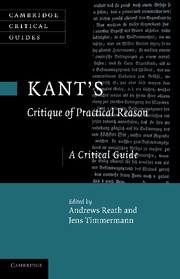Book contents
- Frontmatter
- Contents
- Preface
- List of contributors
- Translations and abbreviations
- Introduction
- 1 The origin and aim of Kant's Critique of Practical Reason
- 2 Formal principles and the form of a law
- 3 Moral consciousness and the ‘fact of reason’
- 4 Reversal or retreat? Kant's deductions of freedom and morality
- 5 The Triebfeder of pure practical reason
- 6 Two conceptions of compatibilism in the Critical Elucidation
- 7 The Antinomy of Practical Reason: reason, the unconditioned and the highest good
- 8 The primacy of practical reason and the idea of a practical postulate
- 9 The meaning of the Critique of Practical Reason for moral beings: the Doctrine of Method of Pure Practical Reason
- Bibliography
- Index
9 - The meaning of the Critique of Practical Reason for moral beings: the Doctrine of Method of Pure Practical Reason
Published online by Cambridge University Press: 06 August 2010
- Frontmatter
- Contents
- Preface
- List of contributors
- Translations and abbreviations
- Introduction
- 1 The origin and aim of Kant's Critique of Practical Reason
- 2 Formal principles and the form of a law
- 3 Moral consciousness and the ‘fact of reason’
- 4 Reversal or retreat? Kant's deductions of freedom and morality
- 5 The Triebfeder of pure practical reason
- 6 Two conceptions of compatibilism in the Critical Elucidation
- 7 The Antinomy of Practical Reason: reason, the unconditioned and the highest good
- 8 The primacy of practical reason and the idea of a practical postulate
- 9 The meaning of the Critique of Practical Reason for moral beings: the Doctrine of Method of Pure Practical Reason
- Bibliography
- Index
Summary
THE ROLE OF KANT'S DOCTRINES OF METHOD
Philosophical works are not always read to the end. The ‘Doctrine of Method of Pure Practical Reason’, presented as the second main part of the Critique of Practical Reason, may be subject to this liability, since it apparently plays no role in the overall argumentative structure of the work. After all the subtle argumentation in the first part of the book, it is difficult to reach page 269 of the original edition and still take into account the possibility that the remaining few pages may add something relevant to the Critique. After such intricate sections as those on the fact of reason, the moral motive or the postulates, the statements contained in the Doctrine of Method sound less profound, even conventional, as they apparently provide mere suggestions for moral education in what may appear as an unnecessary appendix. Although the Doctrine of Method is not the most innovative part of the second Critique, it is important, at least from an exegetical point of view, to try to comprehend why Kant made it the final part of such an ambitious work and what its actual role may be.
Though it may be tempting to see the Doctrine of Method simply as a product of Kant's excessive – some may even say obsessive – fidelity to a rigid constructive pattern, one has only to recall the several occasions in the Critique of Practical Reason where Kant stresses that the subdivisions of the new work correspond only imperfectly to those of the earlier one (see, for example, CpV 5:16, 90 f.).
Keywords
- Type
- Chapter
- Information
- Kant's 'Critique of Practical Reason'A Critical Guide, pp. 197 - 215Publisher: Cambridge University PressPrint publication year: 2010
- 5
- Cited by

